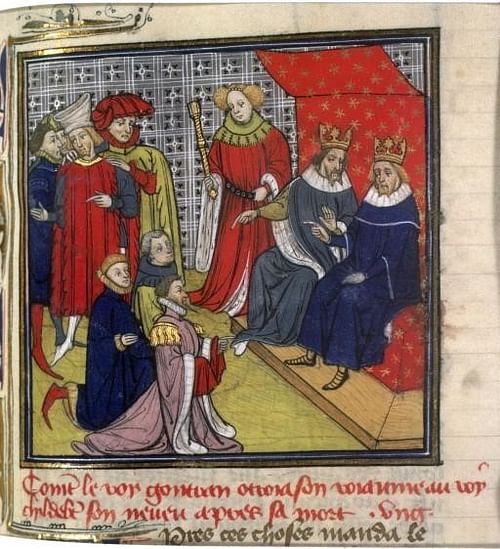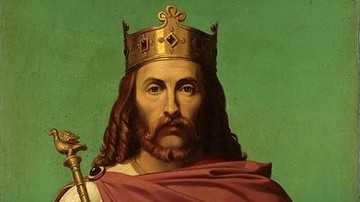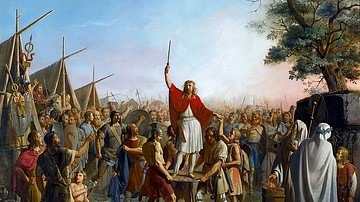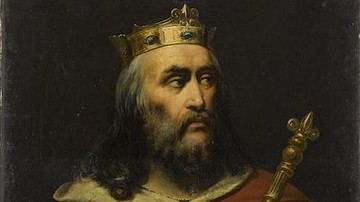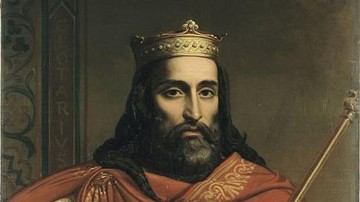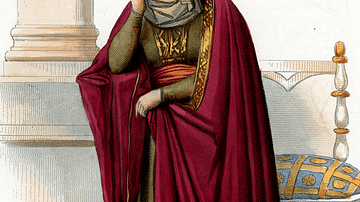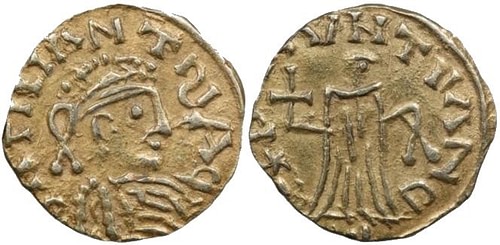
Guntram I (also given as Gontrand, Gunthram, or Gunthchramn) was a Merovingian king who ruled over the Frankish kingdom of Orléans, later referred to as Burgundy, from 561 to 592. He often took on the role of mediator in the disputes between his brothers and later served as guardian over the kingdoms of his two young nephews.
In 561, Guntram inherited one-fourth of the Frankish kingdom, taking his capital at Orléans and ruling over the territory of Burgundy. A shrewd and cunning politician, he worked to ensure that neither of his two feuding brothers, Sigebert I and Chilperic I, accumulated too much power. By 584, both of his brothers had been killed, leaving Guntram as the sole adult Merovingian ruler. He took it upon himself to hold all the kingdoms of Francia in trust for his two young nephews, and for a time, he was the most powerful authority in Francia. In 585, he put down a revolt by his alleged half-brother, Gundovald Ballomer, and adopted his nephew Childebert II as his heir in the Treaty of Andelot in 587.
Guntram was immediately canonized after his death in 592. Despite his shortcomings, he was praised by the bishop and historian Gregory of Tours (538-594), whose famous work, The History of the Franks, is largely concerned with the reigns of Guntram and his siblings. Gregory refers to "good king Guntram" with higher praise than he allows to any other Frankish king and even alleges that Guntram performed miracles while alive.
Succession
Guntram was born in Soissons, probably in 532. His father was King Chlothar I of Soissons (r. 511-561), and his grandfather was King Clovis I (r. 481-511), the first ruler to have united all the Franks into a single kingdom. When Clovis died in 511, his kingdom was divided in equal parts among his four sons. Chlothar, the youngest, spent the next four decades clawing and scratching his way to the top, alternatively allying with, and then plotting against his brothers in his insatiable pursuit of power. In 558, the last of Chlothar's brothers died, allowing him to finally claim Clovis' old title 'King of All the Franks' and rule over a reunited Frankish realm.
But Chlothar's growing power did not spare him the headaches of Merovingian family squabbles. In 555, while the old king was off campaigning against the Saxons, his ambitious son Chramn seized the opportunity to rebel against his father's rule. Guntram and his elder brother Charibert were entrusted by King Chlothar to deal with their insolent half-brother. Likely eager to prove themselves in battle, the brothers tracked Chramn down to Limoges, where the two sides drew up for battle at the foot of a mountain. However, before battle could be joined, Guntram and Charibert received word that Chlothar had been killed. They immediately marched their army back into Burgundy to claim their shares of the inheritance. Of course, the rumor of Chlothar's death had been nothing more than a trick by Chramn to get his brothers off his back. Guntram had failed this early test, and Chramn continued being a thorn in their father's side for five more years, until he was defeated and executed in 560.
King Chlothar himself died in 561, and the Frankish kingdom was again shattered into fourths. As Chramn had been executed the year before, Chlothar was survived by only four of his sons. The eldest, Charibert I (r. 561-567), inherited the lucrative Kingdom of Paris; Guntram I, the second eldest, received the Kingdom of Orléans, which included the territory of Burgundy; Sigebert I (r. 561-575) inherited the eastern kingdom of Austrasia; and Chilperic I (r. 561-584) inherited the Kingdom of Soissons, or Neustria, the smallest of the kingdoms. Charibert, Guntram, and Sigebert were all full brothers, the sons of Chlothar's third wife Ingund, while Chilperic was their half-brother, the son of Chlothar's fourth wife, Aregund.
Partitioning of Charibert's Lands
It was not long before the sons of Chlothar were at each other's throats. In 562, Chilperic invaded Sigebert's territory, starting a quick and pointless civil war in which Guntram did not get involved. Yet the three younger brothers would each get a chance to grab some land in 567 when Charibert I died. Since Charibert had no sons, Guntram, Sigebert, and Chilperic carved up his kingdom among themselves. Control of the city of Paris itself, which had come to symbolize the unity of the Frankish kingdom, was split between all three; each swore an oath that no brother could enter the city without permission from the other two.
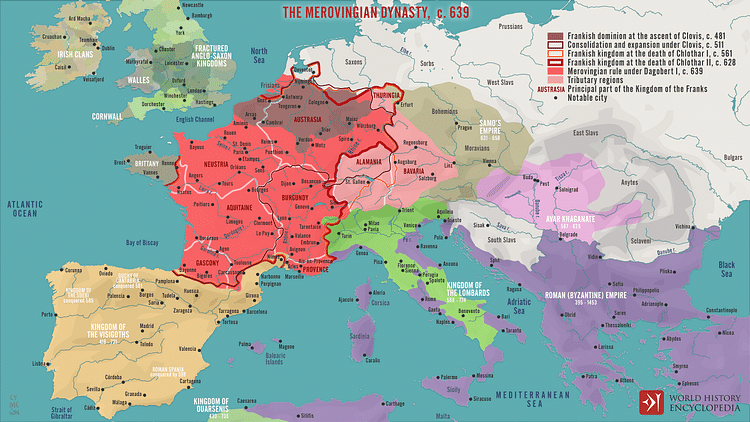
Shortly after Charibert's death, his widow, Theudechild, offered to marry Guntram in the hopes of retaining her queenly influence. Even though a council of bishops had forbidden men from marrying their brothers' wives, Guntram accepted, on the condition that Theudechild bring Charibert's entire treasury with her. Delighted, Theudechild proceeded to gather all her possessions and travel to Guntram's court. But when she arrived, Guntram had the treasury seized, and shipped Theudechild off to live in a nunnery in Arles, where she spent the rest of her life. This was an early example of the type of deceitfulness that Guntram would exhibit throughout his reign.
Marriages & Children
Guntram's first marriage was to Marcatrude, a noblewoman and daughter of a powerful duke. Marcatrude gave birth to a son, but this was not Guntram's firstborn. He had previously fathered a son, Gundobad, with one of his mistresses prior to his marriage with Marcatrude. Gregory of Tours writes that Marcatrude was jealous of Gundobad, likely outraged at the thought that this son of a mistress would one day share power with her own sons. For this reason, she had Gundobad murdered, poisoning his drink.
It was not long, however, before Marcatrude's own son died, something that Gregory attributes to the "judgment of God" (IV.35). The death of their son caused a falling out between the king and queen, and Guntram soon dismissed Marcatrude and took a second wife, Austrechild. This new queen gave birth to two healthy sons, something that greatly angered the family of Marcatrude, who felt scorned and betrayed. When Guntram heard that two of Marcatrude's brothers had been making insulting remarks about his new wife and children, the king lost his temper. He had the brothers executed and seized their lands and valuables.
This was not the only time Guntram would spill blood on Queen Austrechild's behalf. In 580, Austrechild was dying of dysentery. Having become embittered by her situation, she blamed her doctors for purposefully not doing enough to save her and asked Guntram that, in the event of her death, her "wicked doctors" would join her in dying. Once Austrechild finally succumbed, Guntram carried out her last request by having the two doctors executed; Gregory of Tours blames Austrechild alone for their murders, calling her an "evil consort" and commenting, "all those who had any sense at all knew that this was a sinful act" (V. 35). Austrechild's death left Guntram without a wife or heirs; his two sons by Austrechild had both died during a dysentery epidemic in 577.
Civil War
While Guntram was experiencing love and loss, his brothers were having marriage problems of their own. Sigebert I had sought to outshine his brothers by marrying a woman of his own social standing, and so he took a Visigothic princess named Brunhilda as his bride. Not one to be outdone, Chilperic married Brunhilda's elder sister, Galswinth, and bestowed upon her a massive morgangabe, a gift Frankish nobles gave their wives after their first night as a couple. This morgangabe was the largest on record, containing five cities and all their revenues. Yet despite this lavishness, Chilperic would soon have a falling out with his new wife; in 568, he had her strangled to death in her bed before marrying his mistress, Fredegund.
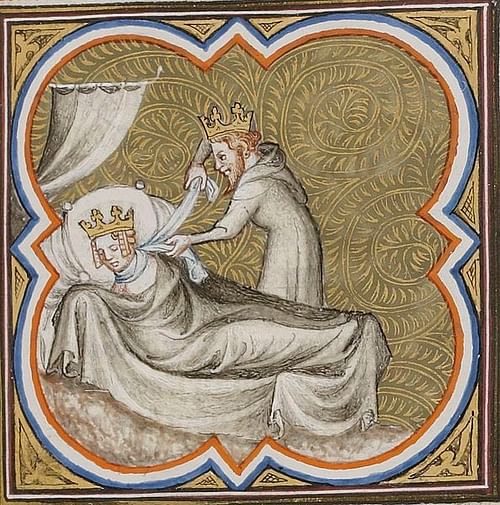
Naturally, this created some friction between Sigebert and Chilperic. As the only brother without a dog in the fight, Guntram was entrusted to preside over the council that had been tasked with mediating the dispute. Eventually, the council decided that Chilperic must pay a weregeld, or restitution, to Queen Brunhilda of Austrasia, who was deemed to be the injured party. This weregeld had to include the five cities Chilperic had initially gifted to Galswinth. Chilperic refused, and in 572, he sent an army to ravage Sigebert's lands. This began a civil war that quickly escalated in scope, causing widescale destruction.
Guntram was careful to maintain the balance of power in Francia and worked to ensure that neither of his brothers became the dominant Frankish king. He allied first with one brother, then the other, but remained relatively unscathed as Sigebert and Chilperic tore up each other's kingdoms. The matter was finally decided in 575, when Sigebert, on the cusp of achieving victory, was assassinated by two servants hired by Queen Fredegund.
Guardian of Francia
Upon Sigebert's assassination, Chilperic attempted to consolidate his victory by annexing the kingdom of Austrasia. This was resisted by the Austrasian nobility, who knew that they stood to lose power if Chilperic took them over. Guntram, who still sought to keep his brother's ambitions in check, also opposed the invasion and sent an army to ensure Austrasia's independence. Guntram's army was led by Eunius Mummolus, a Gallo-Roman patrician who was the greatest military commander of his day in all Francia. Mummolus defeated the Neustrian army and forced Chilperic to abandon his dreams of conquering Austrasia. Meanwhile, the Austrasians crowned Sigebert's five-year-old son, Childebert II (r. 575-596), as their king.
For a while, Guntram maintained a close alliance with his nephew, bonded by their mutual distrust of Chilperic. In 577, when Guntram's last two sons died from dysentery, he even announced his intention to adopt Childebert II as his heir. But in 581, there was a palace coup in Childebert's kingdom, and the boy king's new advisors began to argue with Guntram over the revenues from Marseille. The argument got so bad that the Austrasian nobles broke their treaty with Guntram and made an alliance with Chilperic instead. This Neustrian-Austrasian alliance had the potential to be devastating for Guntram, especially once Chilperic began raiding Guntram's lands in Aquitaine. However, a full-fledged civil war was avoided in 583, when the kingdoms of Guntram and Childebert II patched up their differences and reaffirmed their alliance.
The next year, King Chilperic I was assassinated by an unknown assailant. His kingdom passed to his only surviving son, the four-month-old Chlothar II (r. 584-629). Guntram was initially skeptical of Chlothar II's true parentage; he distrusted the boy's mother, Queen Fredegund, who suspiciously became pregnant again shortly after Chilperic's death. Before acknowledging the boy as the king of Neustria, Guntram required Queen Fredegund and 300 Neustrian nobles to swear solemn oaths that Chlothar II was indeed the natural son of King Chilperic. Once this was done, Guntram's reservations appeared to be satisfied, and he offered Chlothar II the same guarantee of protection that he had given to Childebert II.
By 584, King Guntram was the only adult Merovingian ruler. He presented himself as an elder statesman and peacekeeper, the protector of all of Francia until his two young nephews came of age. Guntram was keenly aware of the fragility of the Merovingian Dynasty; should he die, the dynasty's fate would rest entirely in the hands of two children. Aware that there were some in Francia who wished to see him dead, Guntram spoke before a congregation in Paris, asking any would-be assassins to wait at least three years until Childebert II reached his maturity and the future of the Frankish realms could be secured. Guntram's motives were not entirely selfless, however; he used his position as guardian of all Francia to transfer the allegiances of the cities of Tours and Poitiers from Childebert's kingdom to his own.
Revolt of Gundovald
In 582, a man named Gundovald arrived in Marseille, having journeyed all the way from Constantinople. He had arrived at the invitation of certain Frankish nobles, who remained nameless in the account of Gregory of Tours. Gundovald did not arrive empty-handed but came with treasure provided to him by the Byzantine emperor and a claim: he was the purported son of King Chlothar I and a common woman. If this were true, then Gundovald was the half-brother of King Guntram and was entitled to a share of Chlothar's lands.
Gundovald had made these claims before and had been written off even by Chlothar I himself. But by 584, Gundovald was able to garner an alarming amount of support. He had returned at the invitation of certain Austrasian nobles, who may have been concerned about the growing influence of Guntram and Childebert II's mother, Queen Brunhilda, over their own kingdom. Gundovald was also supported by Neustrian nobles and officials, who had been left without a patron by the death of Chilperic. Most significantly, Gundovald was supported by Guntram's old general, Mummolus, who had fallen out with the king. Mummolus invited Gundovald to his home in Avignon, where he was proclaimed king. Gundovald then began taking oaths of fealty from lands in Aquitaine, some of which had previously belonged to King Chilperic and others still subject to King Guntram.
Guntram, of course, denied that Gundovald was his brother, and rejected any calls for reconciliation. He denounced Gundovald as a ballomer, a Frankish word for "pretender" or "false king". Guntram first tried to diffuse the situation through trickery; he suspected Gundovald was in communication with Queen Brunhilda and sent a letter to Gundovald in which he pretended to be the queen and asked him to dismiss his army. When this failed, he sent an army after Gundovald, who took refuge in the town of Saint-Bertrand-de-Comminges.
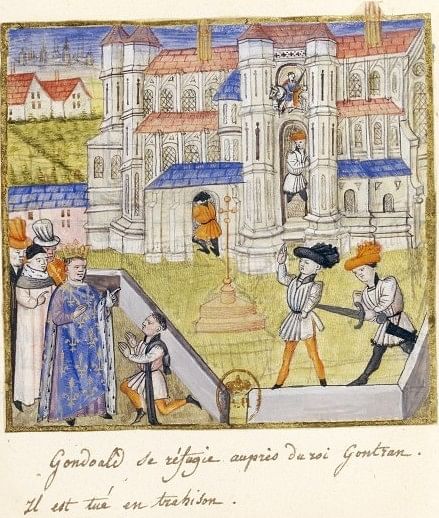
Guntram's men laid siege to the town in 585, but each of their attempts to breach the walls failed. Despite this, it quickly became apparent that it was only a matter of time before the town fell, and Gundovald's supporters began to desert him in droves. Eventually, Mummolus became convinced of the hopelessness of the situation and handed over Gundovald to the besiegers. Gundovald was killed, as was Mummolus, despite the promises that had been made to him. The next day, once the gates of the town were opened, Guntram's men massacred the townsfolk and burned all the buildings to the ground.
Later Reign
Guntram's goal to keep the Merovingian Dynasty alive was advanced in 585 when Childebert II finally came of age. The two kings kept their close alliance alive, although their relationship was not without its rocky patches; for instance, Guntram incurred Childebert's wrath when he refused to hand over Queen Fredegund, who Childebert wanted to put to death for her role in the deaths of his father and two cousins. Yet Guntram continued to act as Childebert's protector. In 587, he supplied his nephew with information suggesting that several Austrasian dukes were conspiring to kill Childebert. These dukes, many of whom had ties to Gundovald's revolt, were put to death. Guntram and Childebert II solidified their alliance in November 587 with the signing of the Treaty of Andelot, in which Guntram formally adopted Childebert as his successor.
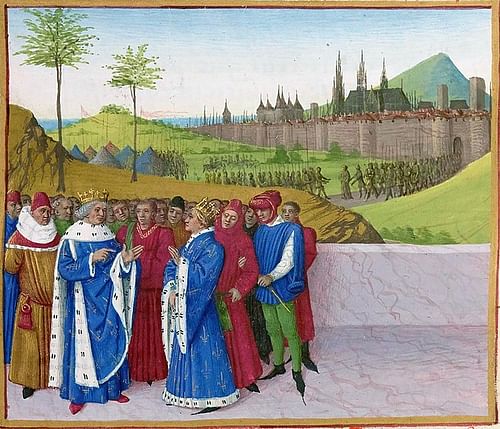
Although he was a peace-loving king, the last years of Guntram's reign saw him send his armies on several campaigns. In 589, he sent an army against the Breton ruler Walloch II; unfortunately, the two men Guntram sent to lead the Frankish army, Duke Beppolem and Duke Ebrachain, were mutual enemies. Ebrachain held back his own men and allowed Beppolem to fight the Bretons for three days on his own until he was eventually killed. Once he was rid of his rival, Ebrachain moved in and defeated the weakened Breton army, forcing Walloch to accept a peace, which turned out to only be temporary. That same year, Guntram also sent an army to take Septimania, a slice of land in southern France held by the Visigoths, but this expedition failed.
Death & Legacy
By the early 590s, Guntram had begun to develop gout and his health was failing. He died at Chalon-sur-Saône on 28 March 592. He was canonized by his subjects immediately after his death; according to Gregory of Tours, Guntram was believed to have performed miracles, making him the only western European king prior to the 11th century who was said to have worked miracles while still alive. The Catholic Church recognizes his feast day on 28 March.

Guntram's legacy is a mostly positive one, thanks to his canonization and the high praise given by Gregory of Tours. Gregory, who refers to him as "good king Guntram", consistently implies that Guntram was the nearest thing to an ideal king during his own lifetime. Yet Guntram was also capable of deviousness and instances of wrath that even Gregory could not ignore; on one occasion, Gregory reports that Guntram had his chamberlain stoned to death, for the petty offense of having hunted aurochs in the royal woods. Likewise, while Guntram presented himself as a selfless guardian of his nephews, he took advantage of the guardianship to expand his own power. However, putting aside the morality of his character, it is true that Guntram helped to preserve the Merovingian Dynasty during a time of crisis and helped protect the power of the Frankish kingdoms.
